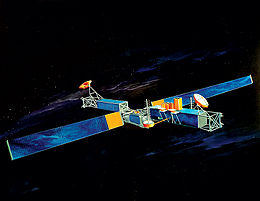This article has multiple issues. Please help improve it or discuss these issues on the talk page. (Learn how and when to remove these messages)
|
 Artist's impression of a Milstar Block I spacecraft | |
| Manufacturer | Lockheed Martin (prime, formerly Lockheed Missiles and Space) Northrop Grumman (formerly TRW) Boeing (formerly Hughes) |
|---|---|
| Country of origin | United States |
| Operator | U.S. Space Force |
| Applications | Military communications |
| Specifications | |
| Bus | Milstar Block I Milstar Block II |
| Launch mass | 4,500 kilograms (9,900 lb) |
| Regime | Geosynchronous |
| Design life | 10 years |
| Production | |
| Status | Out of production Active |
| Built | 6 |
| Launched | 6 |
| Operational | 5[citation needed] |
| Lost | 1 |
| Maiden launch | USA-99, 1994-02-07 |
| Last launch | USA-169, 2003-04-08 |
Milstar (Military Strategic and Tactical Relay)[1] is a constellation of military communications satellites in geosynchronous orbit, which are operated by the United States Space Force, and provide secure and jam-resistant worldwide communications to meet the requirements of the Armed Forces of the United States. Six spacecraft were launched between 1994 and 2003, of which only five were operational after launch; the third launch failed, both damaging the satellite and leaving it in an unusable orbit.